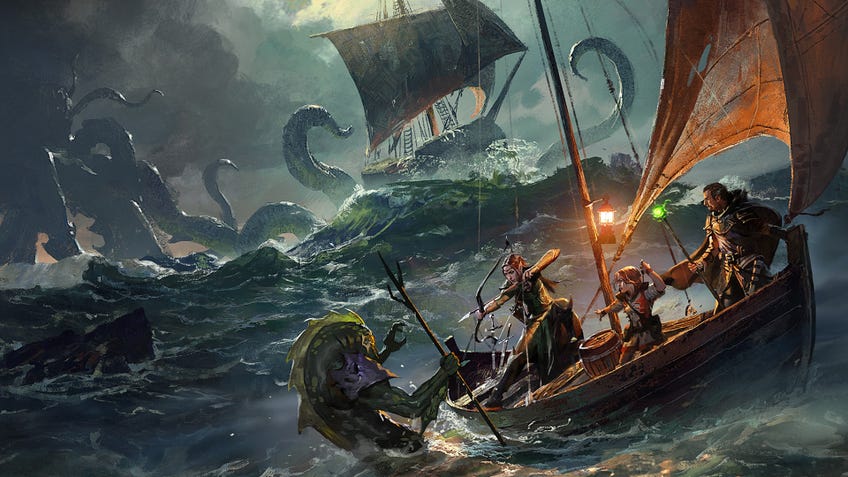Why tabletop roleplaying is best when it’s all in your mind
Mind yourself.
A lush, untamed valley surrounding a waterfall so flawless it reflects like a mirror. A library stuffed with ancient tomes, plush sofas and long shadows. A yawning black pit from which growling whispers and unnatural howls emerge. Dungeons & Dragons lets a DM create any environment, any city, any arena they want and invite the players to imagine it with them. But when it comes to combat, so many roleplaying games are held back by small plastic figures.
‘Theatre of the mind’ is the term used when playing a tabletop RPG without any physical representations of the game space. Obviously, you’ll still have your character sheets and dice, but the characters, the world and all the action that happens between them plays out entirely in the imagination of everyone involved.
It can be daunting and sometimes difficult for a group to collectively imagine a scenario, and theatre of the mind certainly comes with its own challenges. The DM will have to be able to accurately describe the layout of a dungeon in terms that each of the players can understand and interpret without visual aids. The appeal of using maps and figures is clear, and it can even seem like the more interesting and dynamic way to play - especially with the wealth of miniatures and scenery available to make or buy. But they can hold a session back just as much as they improve it.

One of the most annoying issues a DM can encounter while planning and running any roleplaying game is distancing, a problem only compounded with minifigures. When mapping out a dangerous dungeon, it can be hard to position every wall, enemy and trap in exact terms. In theatre of the mind, the DM has enough room to be vague about some things without ruining the atmosphere.
Miniatures and the players that use them demand absolutes when it comes to distance and, on top of making each room in a dungeon more challenging for the DM to create, it also really slows down combat. Saying that you can move up 30 feet and attack an enemy is much quicker than laying out the map, counting the grid squares and formulating a plan.
Even worse, maps and minis can hamper a player’s creativity when it comes to combat. Whereas picturing an epic duel between the forces of evil and the band of heroes can conjure up moves with makeshift weapons, targeting specific areas of the enemy and parkouring across the arena, minifigures are much more grounded. The map transforms any environment into a flat barren space with some obstacles and enemies.
The appeal of using maps and figures is clear, and it can even seem like the more interesting and dynamic way to play - especially with the wealth of miniatures and scenery available to make or buy. But they can hold a session back just as much as they improve it.
In theatre of the mind sessions, players fighting on a beach might throw sand in the face of their adversaries, while minifigures would see the terrain as all the same. Obstacles and furniture also lose any tactical or imaginative characteristics as the players see them, especially when they’re nothing but lines on a grid, annoyances to be skirted around. Not to mention the difficulty of representing multiple floors, flying creatures, anything noteworthy on the ceiling or any measure of verticality with maps and figures.
Playing with minis typically makes the rules much stricter but doesn’t necessarily make the game more ‘realistic’. Figures take up exactly five feet, assuming they’re average size, which means that up to eight characters can surround a single enemy, which seems like far too many given all the weapons and magic being flung around.
On top of the restrictions they impose on the game and the imaginations of the people playing it, miniatures can also be appallingly expensive. On their own, models tend to cost around £10 per figure, so while the party can furnish themselves easy enough, a DM that wants to throw more than a handful of enemies at them is going to struggle.

Then there are dedicated websites like HeroForge that let you accurately render your imagined character in plastic, making it truly personal but tripling the price. Not to mention adding in any structures and scenery to the board is going to push the cost up even higher. Roleplaying games can be one of the most inexpensive ways to spend an evening with your friends, with a one-off book purchase leading to endless hours of fun, that can be expanded as slowly and economically as the DM and players decide.
A lot of other roleplaying games don’t use any sort of physical components during the game. Tragic horror RPG Ten Candles has no miniatures, but still uses the physical space to set the mood, without disturbing or constricting the story. Having the players sit in the ever-encroaching darkness as the titular candles burn during the game adds something without slowing it down, increasing the cost or limiting the players imagination. The recently-released Alien RPG also plays without any models, letting players’ imaginations lead the sci-fi horror story.
Theatre of the mind isn’t for for everyone; in the end, it comes down to your roleplaying group’s personal preference. But while attempting to follow a battle with multiple enemies and allies in your head may seem overwhelming, the alternative only works by reducing the creativity, speed and scope of the conflict.
How a roleplaying campaign should run needs to be decided before the game really gets underway, but everyone should try at least one session with just theatre of the mind. Asking questions and doing something unexpected is half the fun of sharing a game like Dungeons & Dragons - and that happens best when everyone is picturing the world themselves.

